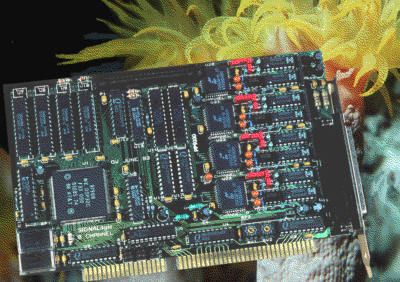Sig32C-8 DSP/Multichannel BoardThis board is not suggested for new applications. It is still supported by Signalogic, and may be available in some limited cases. Please check in with Signalogic.
Click on image to see full-size picture and captions The Sig32C-8 combines a powerful 80 MHz Lucent (AT&T) DSP32C 32-bit floating-point DSP, up to 128k x 32 SRAM, and eight (8) channels of analog I/O together on a 7.5" PC plug-in board. Each channel contains 16-bit sigma-delta A/D and D/A converters and programmable input gain, output attenuation, and sampling rate. The sigma-delta technology gives each channel automatic anti-aliasing and reconstruction filters that track with the programmed sampling rate, and nearly perfect out-of-band rejection and linear phase. Sampling is simultaneous; each channel is DMA'd into DSP memory for further processing and transfer to the host computer. Built-in sampling synchronization and high-speed FIFO data transfers allow the onboard QWbus to be used to combine boards and achieve up to 48 channels of simultaneous sigma-delta analog I/O. Each processor 50 nsec instruction cycle yields up to two (2) 32-bit floating-point operations and up to three (3) simultaneous 32-bit memory accesses, allowing combined 40 MFLOP and 60 MOP operation. Sig32C-8 Feature Summary
Sig32C-8 Specifications and Data Sheets
Sig32C-8 Software SupportThe Sig32C-8 is fully supported by Signalogic's Hypersignal®-Macro and Hypersignal-Acoustic software packages. In addition, both the board and Hypersignal packages can also be used with DirectDSP®, which offers C/C++, Visual Basic, and MATLAB® programming interfaces. Used in conjunction with the Sig32C-8, the DirectDSP/Hypersignal software combination provides sophisticated DSP-based instrumentation, visualization and display of waveforms, block-diagram based automation of development and test sequences, and numerous tools for all levels of DSP product, system, and algorithm development. The complete range of DSP/math functions, interactive waveform display and editing, difference equations, filter design, and real-time code development facilities offered by the software is fully active with the Sig32C-8. Display examples include interactive frequency domain waterfall and contour (joint time-frequency), .WAV display, pole-zero, unwrapped phase, and group delay. Signalogic software takes full advantage of the multichannel capability of the Sig32C-8. Instruments can show any two of the eight channels at once, and any number and combination of the eight channels can be recorded and generated continuously to/from hard disk. Instrumentation includes digital oscilloscope, real-time spectrum analyzer, continuous signal generator (up to 8 channels), stimulus & response measurement, digital tape recorder, and more. The spectrum analyzer allows measurements such as transfer function (deconvolution), impulse response, and selective-band real-time digital filtering to be performed. Additionally, the DSP32C DSP Source Code Interface allows real-time code to be designed, simulated and developed for the DSP32C, and results downloaded, tested and graphically debugged in real-time with the Hypersignal and DirectDSP® software packages. |




